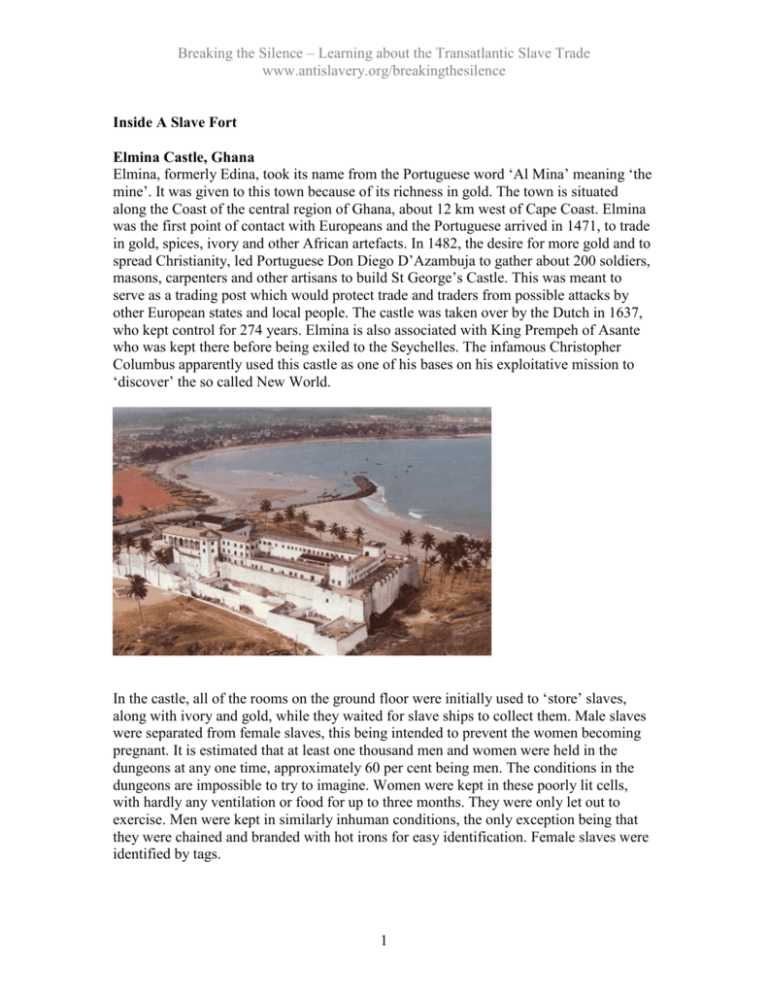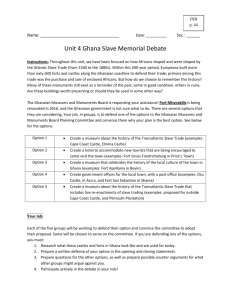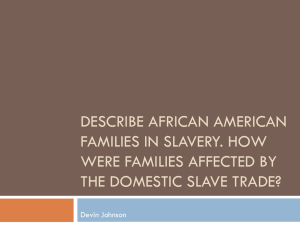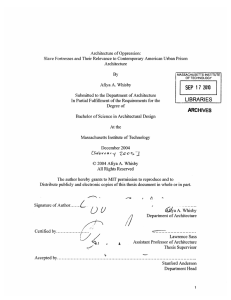Elmina Castle, Ghana - Anti
advertisement

Breaking the Silence – Learning about the Transatlantic Slave Trade www.antislavery.org/breakingthesilence Inside A Slave Fort Elmina Castle, Ghana Elmina, formerly Edina, took its name from the Portuguese word ‘Al Mina’ meaning ‘the mine’. It was given to this town because of its richness in gold. The town is situated along the Coast of the central region of Ghana, about 12 km west of Cape Coast. Elmina was the first point of contact with Europeans and the Portuguese arrived in 1471, to trade in gold, spices, ivory and other African artefacts. In 1482, the desire for more gold and to spread Christianity, led Portuguese Don Diego D’Azambuja to gather about 200 soldiers, masons, carpenters and other artisans to build St George’s Castle. This was meant to serve as a trading post which would protect trade and traders from possible attacks by other European states and local people. The castle was taken over by the Dutch in 1637, who kept control for 274 years. Elmina is also associated with King Prempeh of Asante who was kept there before being exiled to the Seychelles. The infamous Christopher Columbus apparently used this castle as one of his bases on his exploitative mission to ‘discover’ the so called New World. In the castle, all of the rooms on the ground floor were initially used to ‘store’ slaves, along with ivory and gold, while they waited for slave ships to collect them. Male slaves were separated from female slaves, this being intended to prevent the women becoming pregnant. It is estimated that at least one thousand men and women were held in the dungeons at any one time, approximately 60 per cent being men. The conditions in the dungeons are impossible to try to imagine. Women were kept in these poorly lit cells, with hardly any ventilation or food for up to three months. They were only let out to exercise. Men were kept in similarly inhuman conditions, the only exception being that they were chained and branded with hot irons for easy identification. Female slaves were identified by tags. 1 Breaking the Silence – Learning about the Transatlantic Slave Trade www.antislavery.org/breakingthesilence On the first floor, above the slave dungeons, where men and women were held against their will, in deplorable conditions, was the residence for the soldiers and merchants. The second floor was the deputy governor’s residence and the third, was where the governor lived. In the middle of this barbaric place, stood the Portuguese church, where slavers and traders would worship their God. When the Dutch took over in 1637, as they were not Catholic, they divided the church in two, using one part as a junior soldiers mess, and the 2 Breaking the Silence – Learning about the Transatlantic Slave Trade www.antislavery.org/breakingthesilence other as an auction hall where slaves were sold. It is said that this was the first Catholic church in Sub-Saharan Africa and the church has now been turned into a museum. The ‘condemned cell’ was saved for rebellious Africans who resisted their enslavement. There was no escape from this cell, and Africans who were thrown in here were starved until they died. All the captives in the cell were left to die before their rotting, decaying bodies were removed and thrown into the sea. This extreme punishment was mean to serve as a lesson to others against revolt. 3 Breaking the Silence – Learning about the Transatlantic Slave Trade www.antislavery.org/breakingthesilence When the slave ships finally arrived, the women were taken out first through the female slave exit to ‘the room of no return’, where the boats would be waiting. The final exit, the gate of ‘No Return’, was where Africans would leave their homelands and their families forever. It was through here that the Portuguese took their captives to Brazil, the Dutch and later the British, took theirs to the Caribbean and the Americas. 4










